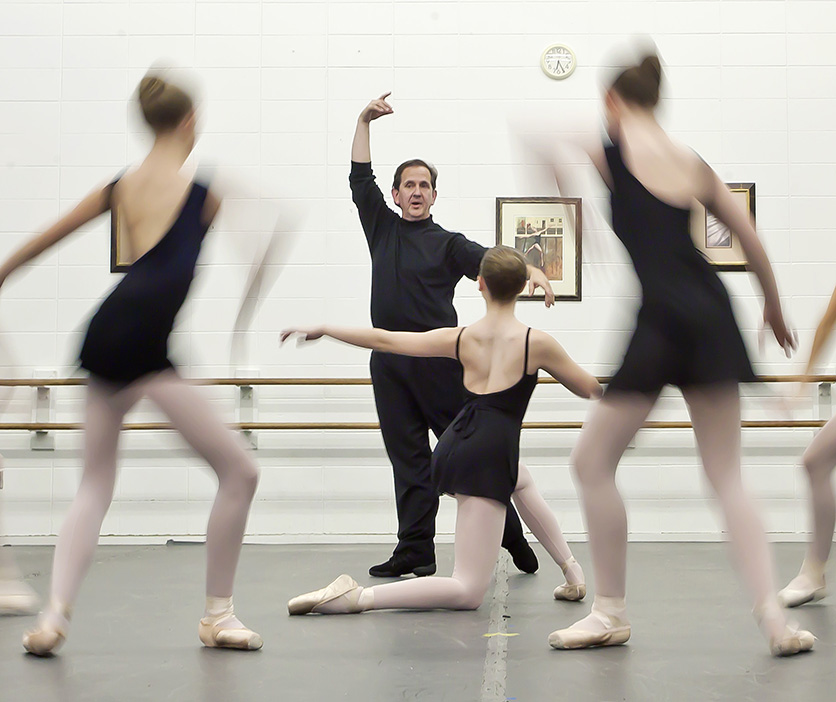Dance of the Mirlitons from “The Nutcracker” frosts the ballet studio with a confectionery Christmas feel.
A half-dozen plucky 12- to 14-year-olds, up en pointe, fluidly sliding to and fro, move with a light, lithe grace that’ll only get more precise, more seemingly effortless with time and polish.
David Keary, Ballet Mississippi artistic director, barely takes his eyes off their steps as he edges to the side.
“These dancers are percolating on a certain level that’s really rewarding,” he says, all smiles and admiration. “They’re like little birds.”
In this arts nest in downtown Jackson, Ballet Mississippi’s young dancers learn the hard work and beauty of ballet. Keary, who at 59 has spent more than 50 years in dance as student, performer, teacher and leader, continues to look for ways to tweak instruction, highlight creativity and give his hometown audience the best dance possible.
Keary, honored for Leadership in Performing Arts, is among the five recipients of Mississippi Arts Commission’s 2018 Governor’s Arts Awards, recognizing significant artistic contributions and excellence in Mississippi and by Mississippians.
Keary’s own dance start came at age 7 with tap, ballet and jazz lessons with the late Jean Shamburger. He was 12 when Jackson Ballet brought in celebrated danseur Edward Villella and ballerina Gelsey Kirkland, then 15, for a show.
“We were just blown away because he was phenomenal, and here was this 15-year-old (Kirkland) out there, just killing it…I looked at my dad and said, ‘That’s what I want to do.’”
In late 1960s/early 1970s Mississippi, “You just didn’t study ballet if you were a guy…and if you did, you’d better be able to learn how to fight or take the heat,” Keary says. But he had his dad’s support and a well-rounded childhood with hunting, fishing, football games and sports, too. When he joined Jackson Ballet in 8th grade as its first male dancer, it made local headlines and word was out. The hard time from friends “wasn’t bad.”
He studied with Albia Kavan Cooper at Jackson Ballet. Her history with George Balanchine’s first company and with choreographer Jerome Robbins became part of the ballet lore the young teen was learning.
A summer scholarship offer to the School of American Ballet got his parents’ OK “after a lot of convincing,” and he recalls his New York City arrival “like right out of those Gene Kelly movies.” That set a summer pattern throughout high school.
Back at Jackson Ballet, a different approach by Thalia Mara, “so much a classicist,” complemented his training — “absolutely part of the big package of what you have to train dancers to do.”
Keary returned to New York in 1978 to stay, and by 1979 was an apprentice with the New York City Ballet for a year, and a company member for the next five years.
“I loved it…just an exhilarating experience.”
On leave from NYCB in 1985, he danced as a principal with Forth Worth Ballet, forging through about a dozen works in a couple of years — ballets he’d never have gotten to do at NYCB. At 29, reluctant to return to New York’s grind with his dancing years closing in, Keary detoured home to Mississippi to finish his education.
Keary finished at Millsaps College and then Mississippi College School of Law and taught ballet wherever he could. He clerked for Mississippi State Supreme Court Justice James W. Smith.
Ballet Mississippi (formerly Jackson Ballet), meanwhile, had been struggling financially for years. Voted onto its board of directors in 1994, Keary soon became its president and keenly felt the frustration when even a Save the Ballet campaign couldn’t rescue it.
“The money was just not there to continue,” he said, and the company folded. Only the school remained. “We had no money and a bunch of creditors and about a $150,000 deficit.”
Loan conditions with the Ballet Mississippi Foundation put Keary at the school’s helm with a businesslike approach and a new board of directors. Support from Foundation leaders Warren Ludlam and Bill Barron was critical in the transition and the school’s redevelopment, Keary said.
He started the year back with 25 kids, which then grew to 40 and a few more in the summer. Somebody suggested a “Nutcracker.” Keary didn’t think he had the numbers. Fall of 1995, registration leaped to 85, “and it wasn’t all creative movement pre-ballet. These were, like, full-bodied kids.
“We started the ‘Nutcracker’ that year, and that’s what got us rejuvenated.”
It’s still an annual Christmas treat and tradition, more than 20 years later. The Ballet Mississippi school has about 250 students now, and a season that includes, too, a Spring Gala and a fall First Moves event. He hopes to develop a fall season. Keary has served on the faculty of International Dance School of the USA International Ballet Competition since 1998. His other artistic outlet: playing guitar in the gypsy jazz combo Swing de Paris.
Keary recreated Ballet Mississippi’s curriculum this year, with more demanding classes for younger students, based on training from the successful Central Pennsylvania Youth Ballet. The focus is less on performance than training dancers on a higher level, so they can compete and hold their own, he said.
As for the Governor’s Arts Award, he’s “beyond grateful and still stunned.” As a pioneer male dancer in Jackson, and among the city’s first dancing pros, with Kathy Thibodeaux (who went on to found Ballet Magnificat!), “there’s just no greater honor,” he said.
Back in the studio, he gives the girls homework, direction, reassurance. “Listen to the music. It’s not as fast as you think it is.” Then he lauds their go-for-it gusto.
The dancers, catching their breath after class, praise his professionalism. Kimberly Blount, 14, of Ridgeland admits she was a bit intimidated at first. “He was very serious. In the end, he helped us a lot. He helped us grow.”
As Eden Wilson, 13, of Ridgeland said, “All the hard stuff — he makes it fun.”

